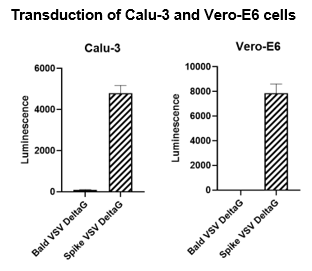Bald VSV Delta G (Luciferase Reporter)
The bald VSV Delta G (Luciferase Reporter) was produced without envelope glycoproteins. It contains the firefly luciferase gene as the reporter. The bald VSV Delta G (Luciferase Reporter) can serve as a negative control when studying virus entry initiated by specific interactions between virus particles and receptors.
| Name | Ordering Information |
| Thaw Medium 1 | BPS Bioscience #60187 |
| Spike (SARS-CoV-2) Pseudotyped VSV Delta G (Luciferase reporter) | BPS Bioscience #78637 |
| Vero-E6 | ATCC #CRL-1586 |
| Calu-3 | ATCC #HTB-55 |
| ONE-Step™ Luciferase Assay System | BPS Bioscience #60690 |
| 96-well tissue culture treated, white clear-bottom assay plate | Corning, #3610 |
The pseudoviruses were produced from HEK293T cells. They are supplied in cell culture medium containing 90% DMEM + 10% FBS.
Vesicular stomatitis virus (VSV) is an enveloped, negative-stranded RNA virus that infects a wide range of animals and less frequently humans, causing mild flu-like symptoms. Its simple structure and its ability to grow in most mammalian cell types has made VSV a valuable tool to study virus entry, replication, and assembly. The glycoprotein of VSV (VSV-G), which binds to the LDL-receptor (low-density lipoprotein receptor), is responsible for the attachment and entry of VSV into a susceptible host cell. Recombinant VSV in which the glycoprotein was deleted (VSV Delta G) can accept viral envelop proteins from a variety of other viruses, allowing to generate pseudotypes that represent robust models to screen for neutralizing antibodies and other inhibitors of virus entry. The pseudoviruses can be engineered to transduce a reporter gene such as Firefly Luciferase or a fluorescent protein, so that viral entry can be monitored using luminescence or fluorescence.


